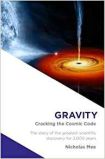Gravity, Cracking the Cosmic Code by Nicholas Mee
| Gravity, Cracking the Cosmic Code by Nicholas Mee | |
|
| |
| Category: Popular Science | |
| Reviewer: George Care | |
| Summary: An accessible and historical approach beginning with early attempts to understand astronomy leading up to Newton's theory of gravity and its publication in his masterpiece the Principia, the book that launched the modern scientific age.Black Holes and Super string theory together with the studies of Einstein, Hubble and Hawking are related to this fundamental force. | |
| Buy? Yes | Borrow? Yes |
| Pages: 404 | Date: October 2014 |
| Publisher: Virtual Image | |
| External links: [www.nickmee.com. Author's website] | |
| ISBN: 978-1901579482 | |
|
| |
Dr Mee’s quest begins with raw data used by Thales of Miletus to make an accurate prediction of a solar eclipse as early as 585 BC recorded in an the account of a battle by Herodotus. Thales analysed the highly accurate data provided by the skilled observations of the Babylonians. Early theories of the heavens are explored in detail with puzzles provided to encourage the reader, for example, to grasp the importance of Galileo’s experiments, Kepler’s revolutionary theories and the towering work of Newton. Midway through this engaging account Dante and the State of Denmark have all been touched upon. This book is a determined attempt to counter the ignorance of the public about basic science, famously propounded by C.P.Snow, and to introduce them to the latest theories about black holes, string theory and to convey the beautiful links between gravity and the theory of small particles, like leptons, with the grand structure of galaxies.
It is Nicholas Mee’s ability to combine incidental personal detail with grand underlying theories of gravitation that makes his study entertaining. Had you heard about Samuel Foster? He was Gresham Professor of Astronomy and fellow of Emmanuel College in 1632 and the author of treatises on quadrants and sundials. More importantly, he encouraged the observational skills of Jerimiah Horrocks who first attended the College, coming from a Toxteth family of watchmakers. Mee shows us how one generation can inspire another.
The young Horrocks, generally little recognised, goes on to use Kepler’s tables whose accuracy he recognises to emphasise the importance of the Sun’s gravity. He explains the effects of the gravitational pull between Jupiter and Saturn. His theoretical ability enables him to explain the irregularities in the Moon’s orbit known as precession. Along with Crabtree he made observations of Venus in transit across the Sun. Mee consistently shows the importance of seemingly small disparities in data. Importantly, he indicates just how scientific knowledge is the product of a particular community and reiterates the importance of high quality scientific education.
The First World War was a very tough time for intellectuals posted into combat. Harold MacMillan consoled himself bravely with Greek Prose. Wittgenstein fighting the allies in the Austro-Hungarian Army and also under extreme conditions made philosophical notes and Schrodinger, an officer in the same Army, the future discoverer of quantum wave mechanics was using his physics to predict the path of projectiles for the Austrian fortress artillery. Schwarzschild who was forty years old and a professor at the prestigious and ancient University of Gottingen was scrambling through trenches on their Eastern Front, also as an artillery officer, not only under attack by the Russians but also beset with a crippling auto-immune skin disease. However, such were his formidable mathematical skills, that he was able to use Einstein’s recently published formulation of General Relativity (1915), and whilst under extreme stress to use symmetry in a novel way. Using this elegant technique he produced a solution to describe the curvature of space-time in a spherical structure such as a star. Such an approach astounded Einstein and continues to inform theoretical astronomy today. Gravity, which is subtitled, Cracking the Cosmic Code abounds with anecdotes, such as these, to enliven the basic Physics. He mentions the human tragedy too; a few months later in 1916 Schwarzschild died without his ground-breaking work gaining significant recognition.
It is interesting that in an historical account intended for the common reader, there comes a point where theories and more particularly equations have to be stated rather than proved in full detail. There is something of a quantum leap from A-level to post-doctorate topics. In general, Mee handles this very well by maintaining interest with engaging stories and simple examples. There are essentially two chapters on Einstein’s theories and sadly, rather too small diagrams which do not facilitate the leap in comprehension. In short, you may be able to find two complete books which will cover this particular ground in detail. In other respects Mee does a sound job. He provides internet and other references in valuable end-notes. The book is lavishly illustrated with 14 coloured plates, but more thought might have been given here over the balance of choice. Personally, I could do without the mystical geometrics which sit somewhat uncomfortably with a mural of Dante and medieval instruments. I was not thoroughly aware of Minkowski’s geometrical contribution to Einstein’s theories and this alone makes up for other minor weaknesses.
In the final chapters examining theories of space-time surfaces and the earliest expansion of the Universe, Mee touches on the essential grandeur of recent discoveries. Deep connections underlie the combination of colliding black holes with fundamental concepts like entropy and time’s arrow. The fascinating variety of supernovae is adumbrated. This book is certainly a challenging read but will repay the reader’s efforts to grasp the majesty of the mathematics of gravity; the force that holds worlds together.
Thanks to Virtual Image Publishing for sending the review copy.
We can also recommend Higgs Force, also by Nicholas Mee and Quantum: Einstein, Bohr and the Great Debate About the Nature of Reality by Manjit Kumar.
Please share on: ![]() Facebook,
Facebook, ![]() Twitter and
Twitter and
![]() Instagram
Instagram
![]() You can read more book reviews or buy Gravity, Cracking the Cosmic Code by Nicholas Mee at Amazon.co.uk Amazon currently charges £2.99 for standard delivery for orders under £20, over which delivery is free.
You can read more book reviews or buy Gravity, Cracking the Cosmic Code by Nicholas Mee at Amazon.co.uk Amazon currently charges £2.99 for standard delivery for orders under £20, over which delivery is free.
![]() You can read more book reviews or buy Gravity, Cracking the Cosmic Code by Nicholas Mee at Amazon.com.
You can read more book reviews or buy Gravity, Cracking the Cosmic Code by Nicholas Mee at Amazon.com.
Comments
Like to comment on this review?
Just send us an email and we'll put the best up on the site.


